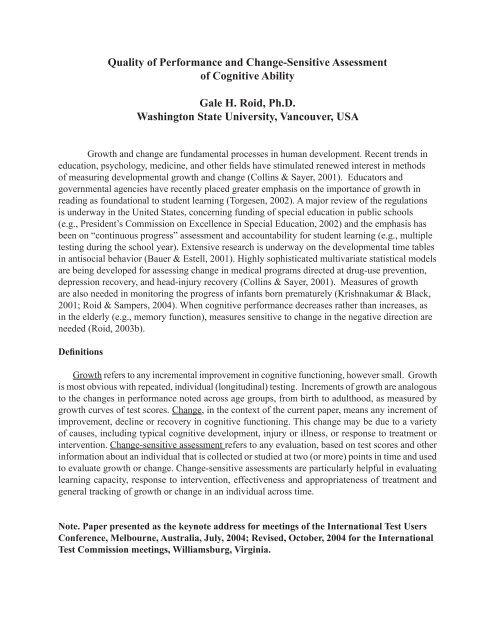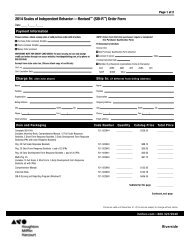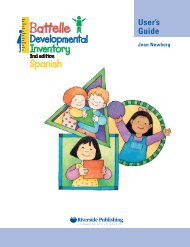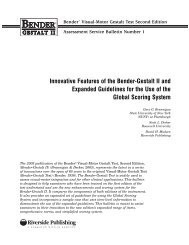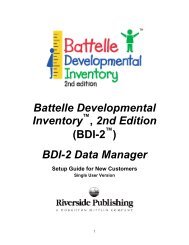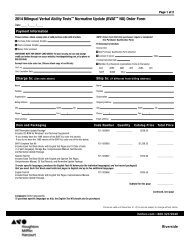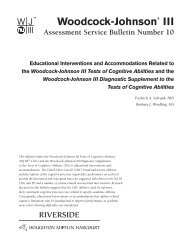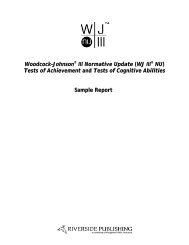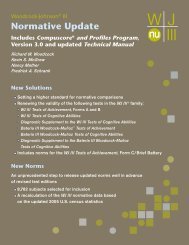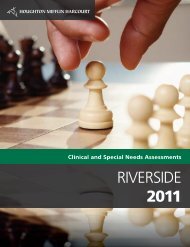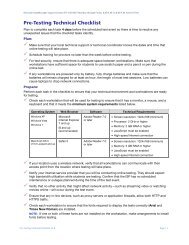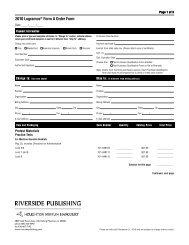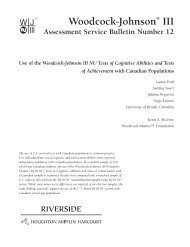Quality of Performance and Change-Sensitive ... - Nelson Education
Quality of Performance and Change-Sensitive ... - Nelson Education
Quality of Performance and Change-Sensitive ... - Nelson Education
You also want an ePaper? Increase the reach of your titles
YUMPU automatically turns print PDFs into web optimized ePapers that Google loves.
<strong>Quality</strong> <strong>of</strong> <strong>Performance</strong> <strong>and</strong> <strong>Change</strong>-<strong>Sensitive</strong> Assessment<strong>of</strong> Cognitive AbilityGale H. Roid, Ph.D.Washington State University, Vancouver, USAGrowth <strong>and</strong> change are fundamental processes in human development. Recent trends ineducation, psychology, medicine, <strong>and</strong> other fields have stimulated renewed interest in methods<strong>of</strong> measuring developmental growth <strong>and</strong> change (Collins & Sayer, 2001). Educators <strong>and</strong>governmental agencies have recently placed greater emphasis on the importance <strong>of</strong> growth inreading as foundational to student learning (Torgesen, 2002). A major review <strong>of</strong> the regulationsis underway in the United States, concerning funding <strong>of</strong> special education in public schools(e.g., President’s Commission on Excellence in Special <strong>Education</strong>, 2002) <strong>and</strong> the emphasis hasbeen on “continuous progress” assessment <strong>and</strong> accountability for student learning (e.g., multipletesting during the school year). Extensive research is underway on the developmental time tablesin antisocial behavior (Bauer & Estell, 2001). Highly sophisticated multivariate statistical modelsare being developed for assessing change in medical programs directed at drug-use prevention,depression recovery, <strong>and</strong> head-injury recovery (Collins & Sayer, 2001). Measures <strong>of</strong> growthare also needed in monitoring the progress <strong>of</strong> infants born prematurely (Krishnakumar & Black,2001; Roid & Sampers, 2004). When cognitive performance decreases rather than increases, asin the elderly (e.g., memory function), measures sensitive to change in the negative direction areneeded (Roid, 2003b).DefinitionsGrowth refers to any incremental improvement in cognitive functioning, however small. Growthis most obvious with repeated, individual (longitudinal) testing. Increments <strong>of</strong> growth are analogousto the changes in performance noted across age groups, from birth to adulthood, as measured bygrowth curves <strong>of</strong> test scores. <strong>Change</strong>, in the context <strong>of</strong> the current paper, means any increment <strong>of</strong>improvement, decline or recovery in cognitive functioning. This change may be due to a variety<strong>of</strong> causes, including typical cognitive development, injury or illness, or response to treatment orintervention. <strong>Change</strong>-sensitive assessment refers to any evaluation, based on test scores <strong>and</strong> otherinformation about an individual that is collected or studied at two (or more) points in time <strong>and</strong> usedto evaluate growth or change. <strong>Change</strong>-sensitive assessments are particularly helpful in evaluatinglearning capacity, response to intervention, effectiveness <strong>and</strong> appropriateness <strong>of</strong> treatment <strong>and</strong>general tracking <strong>of</strong> growth or change in an individual across time.Note. Paper presented as the keynote address for meetings <strong>of</strong> the International Test UsersConference, Melbourne, Australia, July, 2004; Revised, October, 2004 for the InternationalTest Commission meetings, Williamsburg, Virginia.
<strong>Quality</strong> <strong>of</strong> performance methods refer to testing or observational procedures that are designedto identify small increments <strong>of</strong> difference in the quality (not just quantity or presence/absence)<strong>of</strong> actions, behavior, performances, or products created by the target individual being assessed.<strong>Quality</strong>-<strong>of</strong>-performance measures help in the identification <strong>of</strong> borderline, or mild, developmentaldelays because children may obtain “milestones” (behavior occurring at the expected age such aswalking by age 1 year) but with unexpected quality or atypical characteristics.The Role <strong>of</strong> Item Response Theory in <strong>Change</strong>-<strong>Sensitive</strong> AssessmentMajor measurement tools for building change-sensitive assessments have been developedthrough research on item response theory (IRT) models. IRT models (Lord, 1980) are a largefamily <strong>of</strong> mathematical models used to analyze test items, develop collections <strong>of</strong> items, createscales, <strong>and</strong> produce test scores for examinees. Following decades <strong>of</strong> research on IRT models,Embretson (1996) recently asserted that the models had reached such an acceptable level <strong>of</strong>scientific verification that they should replace classical test theory (e.g., Gulliksen, 1950) as the“new rules <strong>of</strong> measurement” in psychology <strong>and</strong> education.The version <strong>of</strong> item response theory that I have applied most <strong>of</strong>ten to individuallyadministeredtests in psychology <strong>and</strong> education is the Rasch model, named for the Danishmathematician, Georg Rasch (Rasch, 1966, 1980). Rasch proposed that performance on atest can be predicted from the ability (A) <strong>of</strong> the examinee <strong>and</strong> the difficulty (D) <strong>of</strong> the item.Embretson (1996) praised the advantages <strong>of</strong> the additive model, based on a fundamental tenet<strong>of</strong> measurement theory—additive decomposition—in which two parameters are related to athird variable (e.g., a measurement scale) by an additive (subtractive) relationship. Embretsonsaid, “In the Rasch model, additive decomposition is achieved; the log odds that a personendorses or solves an item is the simple difference between his or her trait level….<strong>and</strong> the item’sdifficulty…” (p. 348).The SB5 <strong>and</strong> Rasch AnalysisThe Rasch model was used in several ways <strong>and</strong> in several stages <strong>of</strong> the development<strong>of</strong> Stanford-Binet Intelligence Scale, Fifth Edition (SB5, Roid, 2003a). Some <strong>of</strong> the importantuses <strong>of</strong> the model <strong>and</strong> its advantages included item analysis, item calibration, <strong>and</strong> development<strong>of</strong> change-sensitive scores (CSS) for each <strong>of</strong> the major summative scores (4 IQ scores <strong>and</strong> 5cognitive-factor indexes). With the Rasch model, both item difficulty <strong>and</strong> examinee ability arescaled in the same measurement metric. Difficulty calibrations <strong>and</strong> ability are initially estimatedby computer programs <strong>and</strong> the values appear as normal-curve z-scores (called “logits” or logunits, Lineacre & Wright, 2000), ranging from minus 4.0 to plus 4.0. For better interpretability,the difficulty values
for each SB5 item <strong>and</strong> the resulting CSS (estimates <strong>of</strong> examinee ability) were converted to theW-scale developed by Woodcock <strong>and</strong> Dahl (1971). The W-scale transforms the initial logitvalues by centering them at 500 <strong>and</strong> using a special expansion factor <strong>of</strong> 9.1024, developedby Woodcock <strong>and</strong> Dahl. Thus, the CSS scale <strong>and</strong> item difficulty scale for SB5 ranges fromapproximately 425 for 2-year old children to 525 for adults, with a central value <strong>of</strong> 500 locatedat the mean performance level <strong>of</strong> children 10 years, 0 months <strong>of</strong> age (beginning fifth gradeapproximately). The CSS scale <strong>and</strong> item difficulty have a criterion-referenced interpretationbased on age equivalence, task characteristics (e.g., complexity <strong>of</strong> the SB5 items), <strong>and</strong> overallsequence <strong>of</strong> cognitive development suggested by the scale. As a child progresses upward onthe scale, he or she is capable <strong>of</strong> mastering increasingly complex tasks <strong>and</strong> solving increasinglychallenging problems. This progress mirrors the development <strong>of</strong> the brain, the growth <strong>of</strong>academic competencies, <strong>and</strong> the accumulation <strong>of</strong> general knowledge. In addition to normreferencing,where the child is compared to peers <strong>of</strong> the same age, the CSS scale allows forcriterion-referencing to task complexity, <strong>and</strong> age-related milestones such as the achievement <strong>of</strong>reading fluency or the various stages in mathematical competence.CSS scores are available for Full Scale, Nonverbal, Verbal, <strong>and</strong> Abbreviated IQ <strong>and</strong> forthe five cognitive factors from the Cattell-Horn-Carroll theory (Carroll, 1993; Horn & Cattell,1966; Flanagan, 2000). When these CSS scores are plotted across age groups, using crosssectional(not longitudinal data), the classic “growth curve” shapes are evident. The cognitivefactorcurves increase from the early childhood years through the early twenties, <strong>and</strong>, then,depending on the cognitive factor being measured, begin to show declining scores in older agegroups. Memory CSS scores show the most rapid decline across elderly age groups, perhaps dueto the emergence <strong>of</strong> dementia, Alzheimer’s disease, etc. An exception is the crystallized (GeneralKnowledge <strong>and</strong> Vocabulary) ability factor which shows continuing improvement into the late50’s among older adults.Rasch Growth Scores in Other TestsPrevious applications <strong>of</strong> the Rasch model were made in the Woodcock-JohnsonPsychoeducational Battery, Revised (Woodcock & Johnson, 1989), the Toddler <strong>and</strong> InfantMotor Evaluation test (TIME, Miller & Roid, 1994), in the Leiter International <strong>Performance</strong>Scale, Revised ( Leiter-R, Roid & Miller, 1997), <strong>and</strong> in the new Merrill-Palmer DevelopmentalScales, Revised (MP-R, Roid & Sampers, 2004). These instruments <strong>and</strong> the “growth scores”in them have generally been received positively by pr<strong>of</strong>essionals working with disabilitiesor developmental delay. The potential is great for detailed tracking <strong>of</strong> growth or changeacross time, <strong>and</strong> the interpretive power <strong>of</strong> criterion-referenced scales such as CSS. A strikingconsistency across national st<strong>and</strong>ardizations <strong>and</strong> across test developers has begun to emergewhen the CSS or Growth or W-scale scores are compared across cognitive batteries such as theSB5, the WJ-R, the TIME, the Leiter-R, <strong>and</strong> the MP-R. The Rasch-based scores on each <strong>of</strong> thesetests have been anchored to the value <strong>of</strong> mean score <strong>of</strong> children, age 10 years, 0 months (or, inthe case <strong>of</strong> the MP-R, at 460 for age 4 years, 0 months). Theoretically, the ends <strong>of</strong> each scale
could them depart in various ways across batteries. However, excellent consistency has beenachieved across these diverse test batteries (e.g., consistency <strong>of</strong> 425 as a value at age 2).<strong>Quality</strong> <strong>of</strong> <strong>Performance</strong> <strong>and</strong> <strong>Change</strong>-<strong>Sensitive</strong> MeasurementAnother important advance in measurement that makes change-sensitive assessmentpossible is the development <strong>of</strong> instruments sensitive to the quality <strong>of</strong> the individual’sperformance. Rather than simple counts <strong>of</strong> the number <strong>of</strong> correct responses or the number <strong>of</strong>behavioral milestones achieved on schedule (e.g., early vocabulary before age 1, walking atabout age 1, learning to read by age 8 or 9), the unique quality <strong>of</strong> responses can be observed <strong>and</strong>recorded. Examples <strong>of</strong> performance quality assessments are listed below <strong>and</strong> will be described inmore depth in the presentation:Movement <strong>Quality</strong> in Infants <strong>and</strong> Toddlers. For example, quality <strong>of</strong> movement ininfants <strong>and</strong> toddlers was studied as part <strong>of</strong> the development <strong>of</strong> a test called the Toddler <strong>and</strong>Infant Motor Evaluation (TIME, Miller & Roid, 1994). Detailed observations <strong>of</strong> children withboth typical <strong>and</strong> atypical motor development were taken <strong>and</strong> detailed illustrations <strong>of</strong> children invarious movement positions were drawn. Examiners using TIME can observe a child movingfrom a prone position to st<strong>and</strong>ing in a 12-month old child, for example. Observations are madeevery 5 seconds <strong>and</strong> recorded on the test. The pattern <strong>of</strong> the movements, not simply the finalposition (st<strong>and</strong>ing) is important in identifying mild <strong>and</strong> moderate developmental delays. Thechild should roll over, use h<strong>and</strong>s, arms, <strong>and</strong> knees to lift himself or herself from the floor, <strong>and</strong>then use one leg (with perhaps a h<strong>and</strong> on a chair) to move to a st<strong>and</strong>ing position, in the typicalpattern. Odd positions <strong>of</strong> h<strong>and</strong>s, arms, back, legs, etc., may indicate atypical movement. Thus,the quality <strong>of</strong> the movement is assessed with the TIME system. Miller <strong>and</strong> Roid (2003) used asequence comparison method (Jackson, 1990; Sellers, 1974) to compare typical patterns (storedin a computer program) to the patterns observed in typical <strong>and</strong> atypical children, with excellentdiscrimination. Details <strong>of</strong> the method <strong>and</strong> research will be discussed in the paper.<strong>Quality</strong> <strong>of</strong> Cognitive <strong>Performance</strong> on the SB5. Guidelines for interpreting the Stanford-Binet, Fifth Edition (Roid, 2003a) include recommendations for the qualitative assessment<strong>of</strong> child performance on certain subtests <strong>and</strong> items. For example, the quality <strong>of</strong> fine motormovement exhibited by children while assembling the pieces <strong>of</strong> the Form Board or FormPatterns tasks can vary from exceptional, typical, to unusual <strong>and</strong> atypical movement, modes <strong>of</strong>grasping the pieces, etc. Most striking, the strategies used by the child to sort the picture chipsin the Verbal Fluid Reasoning task are very interesting. The task is to sort the chips into groups<strong>of</strong> three. Some children only use very concrete categories such as color. Others use functionalcategories such as “writing utensils,” or “play equipment,” revealing the quality <strong>of</strong> theirdevelopmental level <strong>of</strong> thinking. Such qualitative details can be lost if the tasks are not designedto allow their observation or if examiners do not attend to them.
Play-Based <strong>Quality</strong> <strong>of</strong> <strong>Performance</strong> Measures: The MP-R. The new revision <strong>of</strong> theclassic Merrill-Palmer Developmental Scales (Stutsman, 1948; Roid & Sampers, 2004) includesseveral toy-based tasks that tap the quality <strong>of</strong> infant <strong>and</strong> child cognitive <strong>and</strong> fine-motor abilities.A ‘spin toy’ reveals the infants quality <strong>of</strong> h<strong>and</strong> movement <strong>and</strong> h<strong>and</strong>-eye coordination. The‘problem box’ (a clear plastic box with interior shelves into which a small toy is inserted withthe task to extract the toy) reveals many problem-solving (fluid reasoning) strategies in children.Some children shake the box <strong>and</strong> pound in on the floor or table. Others try to reach into the smallopenings in the box. Others discover the bottom “flap” <strong>and</strong> open it to extract the toy. These toybasedtasks provide great richness <strong>of</strong> quality performance assessment, <strong>and</strong> provide indicators<strong>of</strong> advanced, typical, or delayed/atypical performance for purposes <strong>of</strong> early identification <strong>of</strong>developmental disabilities.Assessment <strong>of</strong> Essay Writing in School Children. Data on 10,000 students in thepublic schools <strong>of</strong> the State <strong>of</strong> Oregon (USA) were studied by Roid (1994). Essays from thesestudents were graded using a 6-point, analytical trait method <strong>of</strong> performance assessment withsubstantial inter-rater reliability. The ratings produce 6 trait scores for each essay (each student)on dimensions such as quality <strong>of</strong> word choice, grammar <strong>and</strong> mechanics, creative expression(“voice”), organization, etc. Roid (1994) used cluster analysis to identify groups <strong>of</strong> students withsimilar patterns <strong>of</strong> trait scores <strong>and</strong> found groups that had high creativity versus poor mechanics<strong>of</strong> writing.Assessment <strong>of</strong> Fluid Reasoning in Infants. One challenging area <strong>of</strong> assessment isidentifying the quality <strong>of</strong> fluid reasoning in children under the age <strong>of</strong> 2 years. Prior to workon the Merrill-Palmer revision (MP-R), few published tests provided st<strong>and</strong>ardized measures<strong>of</strong> infant reasoning, except the Bayley Scales <strong>of</strong> Infant Development <strong>and</strong> a few others. Also,existing measures did not have “change-sensitive scores” or quality-<strong>of</strong>-performance items as inthe MP-R. Now, the MP-R provides a downward extension <strong>of</strong> Woodcock’s W-scale down to avalue <strong>of</strong> approximately 327 for age 1 month, based on cognitive play-based tasks, observations<strong>of</strong> eye-movements in tracking toys, etc. These findings will be discussed in the context <strong>of</strong> thechallenge <strong>of</strong> early assessment <strong>of</strong> fluid reasoning.<strong>Change</strong> <strong>Sensitive</strong> Assessment <strong>and</strong> the Evaluation <strong>of</strong> Cognitive Delays in Premature InfantsAssessing premature infants is an area <strong>of</strong> important advancement promised by thedevelopment <strong>of</strong> change-sensitive scores <strong>and</strong> methods <strong>of</strong> measuring quality <strong>of</strong> performance. Aspart <strong>of</strong> a federally-funded research program, the developers <strong>of</strong> the Merrill-Palmer DevelopmentalScale, Revised (MP-R, Roid & Sampers, 2004) have begun to study the problem <strong>of</strong> using “agecorrections” on developmental scales. Because premature infants are <strong>of</strong>ten born 4 to 8 weeks priorto typical gestation, scores on their future developmental tests are <strong>of</strong>ten “corrected” by using normtables one or two months lower than the chronological age (measured from birth) for those infants.Lems, Hopkins, & Samsom (1993) suggested that a full correction for children in the first 6 months<strong>of</strong> life may overestimate the child’s score <strong>and</strong> that a lack <strong>of</strong> correction will underestimate the child’sabilities. The correction may mask a true delay. When, exactly, does the correction diminish <strong>and</strong>by
what magnitude? Aylward (2002; 1997) suggests that the degree <strong>of</strong> correction to accurately predictoutcomes <strong>of</strong> premature infants will require an algorithm based on the age <strong>of</strong> the infant, backgroundrisk factors, <strong>and</strong>, importantly, the domain <strong>of</strong> cognitive, motor, or language behavior being assessed.Recent research using the new MP-R will be reviewed to show progress made in examining theage correction dilemma.SUMMARYMore than a decade <strong>of</strong> research has been conducted to study <strong>and</strong> develop instrumentssensitive to developmental growth <strong>and</strong> decline in cognitive functioning. Many applications toimportant assessment problems in education, psychology, medicine, special education, <strong>and</strong> infantevaluation have been discussed. Many challenges remain for future researchers, including continuingstudies using true longitudinal research designs, experimental studies <strong>of</strong> premature infants “catchingup,” <strong>and</strong> studies <strong>of</strong> early-emerging cognitive abilities such as fluid reasoning. Possible technologydevelopments in the future may be promising, such as use <strong>of</strong> personal (“palm”) data-collectiondevices to test children more frequently across time. Finally, one <strong>of</strong> the promising advantages <strong>of</strong>change-sensitive assessment is the ability to show parents <strong>of</strong> children with special needs that theirchildren are making progress predicted by the patterns <strong>of</strong> documented growth curves.ReferencesAylward, G.P. (2002). Methodological issues in outcome studies <strong>of</strong> at-risk infants. Journal <strong>of</strong> Pediatric Psychology,27(1), 37-45.Aylward, G. P. (1997). Conceptual issues in developmental screening <strong>and</strong> assessment. Journal <strong>of</strong> Developmental <strong>and</strong>Behavioral Pediatrics, 18(5), 340-349.Bauer, D. J., & Estell, D. B. (2001). Cluster analysis <strong>of</strong> developmental pr<strong>of</strong>iles: Relations between trajectories <strong>of</strong>aggression <strong>and</strong> popularity over adolescence. In L. Collins & A. Sayer (Eds.), New methods for the analysis<strong>of</strong> change. (pp. 385-387) Washington, DC: American Psychological Association.Carroll, J.B. (1993). Human cognitive abilities: A survey <strong>of</strong> factor-analytic studies. New York: Cambridge UniversityPress.Collins, L. M., & Sayer, A. G. (Eds.) (2001). New methods for the analysis <strong>of</strong> change. Washington, DC: AmericanPsychological Association.Embretson, S.E. (1996). The new rules <strong>of</strong> measurement. Psychological Assessment, 8, 341-349.Flanagan, D. (2000). Wechsler-based CHC cross-battery assessment <strong>and</strong> reading achievement. School PsychologyQuarterly, 15, 295-329.Horn, J.L., & Cattell, R.B. (1966). Refinement <strong>and</strong> test <strong>of</strong> the theory <strong>of</strong> fluid <strong>and</strong> crystallized intelligence. Journal <strong>of</strong><strong>Education</strong>al Psychology, 57, 253-270.Gulliksen, H. (1950). Theory <strong>of</strong> mental tests. New York: Wiley.Jackson, D. F. (1990). The use <strong>of</strong> sequence analysis algorithms in research on computer-assisted problemsolving strategies. Paper presented at the meetings <strong>of</strong> the American <strong>Education</strong>al Research Association,Boston, April.Krishnakumar, A., & Black, M. (2001). Estimating cognitive growth curves from environmental risk factors: Mediatingthe role <strong>of</strong> parenting <strong>and</strong> child factors. In L. Collins & A. Sayer (Eds.), New methods for the analysis <strong>of</strong> change.(pp. 414-415) Washington, DC: American Psychological Association.Lems, W., Hopkins, B., & Samson, J. F. (1993). Mental <strong>and</strong> motor development in preterm infants: the issue <strong>of</strong> correctedage. Early Human Development, 34, 113-123.Lincacre, J.M., & Wright, B.D. (2000). WINSTEPS v. 3.00: Rasch item analysis computer program manual. Chicago:MESA Press.Lord, F.M. (1980). Applications <strong>of</strong> item response theory to practical testing problems. Hillsdale, NJ: Erlbaum.Miller, L.J. & Roid, G.H. (1994) The T.I.M.E. Toddler <strong>and</strong> Infant Motor Evaluation. San Antonio, TX:The Psychological Corporation.
President’s Commission on Excellence in Special <strong>Education</strong>. (2002). A new era: Revitalizing special education forchildren <strong>and</strong> their families. Washington, DC: U. S. Department <strong>of</strong> <strong>Education</strong>.Rasch, G. (1966). An item analysis which takes individual differences into account. British Journal <strong>of</strong>Mathematical <strong>and</strong> Statistical Psychology, 19, 49-57.Rasch, G. (1980). Probabilistic models for some intelligence <strong>and</strong> attainment tests. Chicago: University <strong>of</strong>Chicago Press.Roid, G. H. (2003a). Stanford-Binet Intelligence Scales, Fifth Edition examiner’s manual. Itasca, IL: Riverside.Roid, G. H. (2003b). Stanford-Binet Intelligence Scales, Fifth Edition technical manual. Itasca, IL: Riverside.Roid, G.H. (1994). Patterns <strong>of</strong> writing skills derived from cluster analysis <strong>of</strong> direct-writing assessments.Applied Measurement in <strong>Education</strong>, 7, 159-170.Roid, G.H., & Miller, L.J. (1997). Leiter International <strong>Performance</strong> Scale--Revised manual. Wood Dale,IL: Stoelting.Roid, G.H., & Sampers, J. (2004). Merrill-Palmer Developmental Scale—Revised manual. Wood Dale, IL:Stoelting.Roid, G. H., & Woodcock, R. W. (2000). Uses <strong>of</strong> Rasch scaling in the measurement <strong>of</strong> cognitive development<strong>and</strong> growth. Journal <strong>of</strong> Outcome Measurement, 4(2), 579-594.Sellers, P. H. (1974). On the theory <strong>and</strong> computation <strong>of</strong> evolutionary distances. SIAM Journal <strong>of</strong> AppliedMathematics, 26, 787-793.Stutsman, R. (1948). Merrill-Palmer scale <strong>of</strong> mental tests. Wood Dale, IL: Stoelting.Torgesen, J. K. (2002). The prevention <strong>of</strong> reading difficulties. Journal <strong>of</strong> School Psychology, 40, 7-26.Woodcock, R. W., & Dahl, M. N. (1971). A common scale for the measurement <strong>of</strong> person ability <strong>and</strong> test itemdifficulty. (AGS Paper No. 10). Circle Pines, MN: American Guidance Service.Woodcock, R.W., & Johnson, M.B. (1989). Woodcock-Johnson Tests <strong>of</strong> Cognitive Ability--Revised.Chicago: Riverside.Wright, B.D. & Stone, M.H. (1979). Best Test Design Chicago: Mesa Press.


